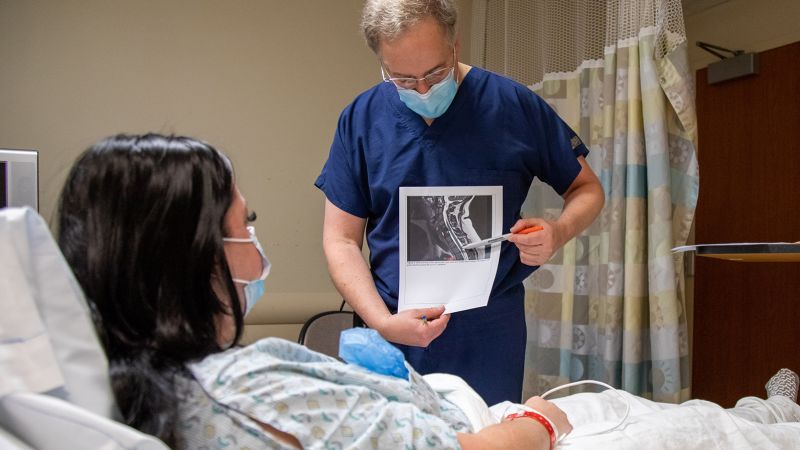
New technology gives hope to stroke patients with paralysis
CNN
—
For practically a ten years, Heather Rendulic has not been ready to use her still left hand to feed herself or decide on up a little something as gentle as a soup can – but that changed when she became section of a scientific trial that could radically improve the life of persons who’ve been paralyzed immediately after a stroke.
The results of that trial were posted Monday in the journal Character Medication.
Rendulic has a uncommon brain condition identified as cavernous angioma, a blood vessel abnormality that can result in stroke. She experienced series of them – 5 whole – about a interval of 11 months when she was just 22 several years outdated that still left her paralyzed on her left side.
“The most demanding part of my condition is residing one-handed in a two-handed entire world,” the Pittsburgh resident mentioned.
A stroke cuts off the blood source to the mind, and cells get started to die in just minutes. A particular person can have paralysis if the stroke damages the element of the mind that sends messages to bring about muscular tissues to transfer.
Rendulic finally regained some functionality on her still left facet, but she was still unable to use a fork or make a fist with that hand.
In 2021, as a component of a joint undertaking among the College of Pittsburgh and Carnegie Mellon College, scientists implanted a pair of thin metal electrodes alongside her neck.
Medical doctors previously use spinal twine stimulation technological innovation to treat persistent soreness. Analysis has proven that the technology could be utilized to restore leg movement following a spinal wire injuries, but hand movements are a small trickier. A hand that capabilities appropriately has a exclusive kind of dexterity and a vast vary of motion.
For the trial, researchers implanted electrodes together the surface area of the spinal cord that look like strands of spaghetti. The electrodes give little impulses that promote specific areas and activate nerve cells inside the spinal wire.
“The sensory nerves from the arm and hand ship alerts to motor neurons in the spinal twine that manage the muscular tissues of the limb,” claimed analyze co-author Dr. Douglas Weber, a professor of mechanical engineering at the Neuroscience Institute at Carnegie Mellon University. “By stimulating these sensory nerves, we can amplify the exercise of muscle tissues that have been weakened by stroke. Importantly, the individual retains comprehensive handle of their movements: The stimulation is assistive and strengthens muscle activation only when clients are hoping to transfer.”
This technologies could function with a broad vary of patients, the researchers claimed.
Rendulic mentioned the stimulation feels “kind of like a tickle.” It is by no means agonizing, but it takes a tiny acquiring utilized to.
As very small black plastic bins gentle up and flashing green lights journey up and down her arm, the product enables motion that would have been unthinkable several years back.
Even on the initial working day, she had a new array of movement. She did not have to be revealed how to open up the hand or arrive at the arm, the scientists mentioned. For extra elaborate responsibilities, a tiny training was wanted.
“When the stimulation is on, I feel like I now have regulate of my arm and my hand again that I haven’t experienced in around nine yrs,” she mentioned.
Rendulic can carry her arm higher than her head, use a fork to convey foods to her mouth, and fully open up and near her fist. The other man or woman taking part in the demo experienced in the same way promising outcomes.
At one position throughout the trial, Rendulic picked up a soup can and introduced it on a marked spot on a board. The lab all-around her erupted in cheers, and she pumped her other arm in the air in triumph.
“It’s just brilliant,” she said.
The researchers received yet another nice shock, much too: “We discovered that right after a handful of weeks of use, some of these advancements endure when the stimulation is switched off, indicating remarkable avenues for the potential of stroke therapies,” reported research co-author Dr. Marco Capogrosso, an assistant professor of neurological surgical procedure at Pitt.
This means even following the device is taken off, with some powerful physical schooling, topics may perhaps have extensive-phrase advancements, the researchers mentioned.
No solutions are viewed as productive for treating paralysis six months or more after a stroke, in what health professionals simply call the long-term stage.
The stimulation know-how desires to be analyzed even more, but it has terrific potential, the researchers said.
And it could fill a escalating have to have. Medical professionals forecast that 1 in every single 4 persons around the age of 25 will have a stroke in their lifetime, and numerous will create some kind of paralysis, in accordance to the Planet Stroke Organization.
“Creating successful neurorehabilitation solutions for men and women affected by motion impairment after stroke is turning out to be at any time a lot more urgent,” explained study co-author Dr. Elvira Pirondini, an assistant professor of actual physical medication and rehabilitation at Pitt.
“Even gentle deficits resulting from a stroke can isolate people today from social and skilled life and grow to be really debilitating, with motor impairments in the arm and hand remaining specially taxing and impeding very simple day by day actions, these types of as writing, having and finding dressed.”
